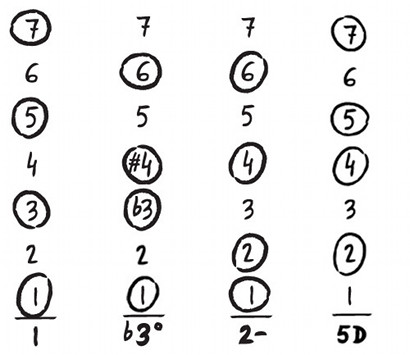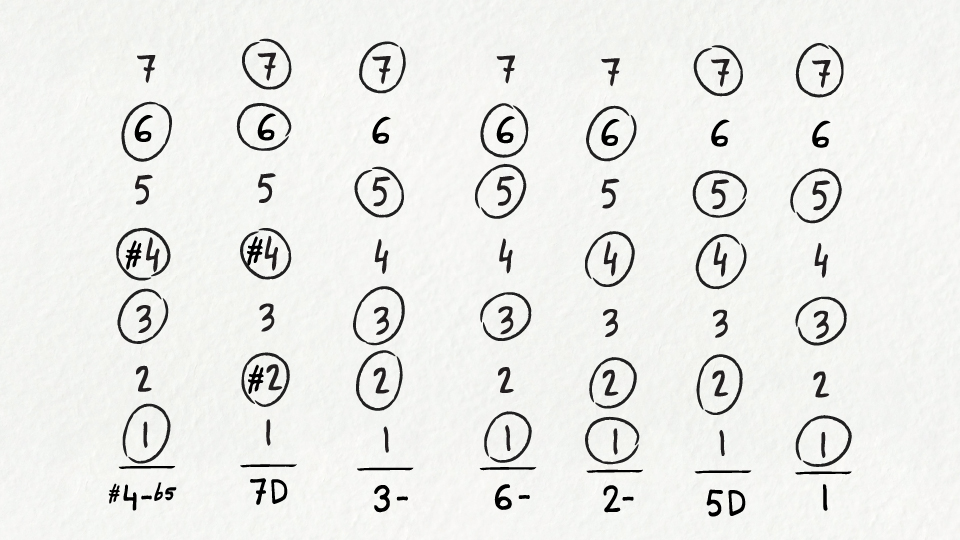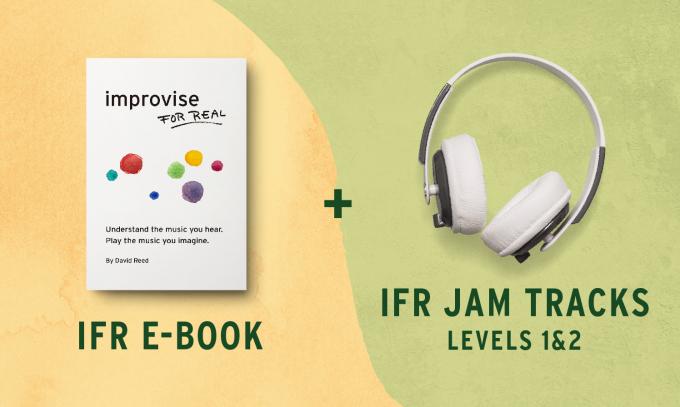Hi David,
I'm intrigued by your harmonic analysis with circles around some numbers. I would like to kindly ask why are those numbers put in circles?
What interests me is the harmonic analysis of Bye Bye Blackbird, especially the line with the flat 3rd diminished. Thank you very much indeed.
Paula
David's response:
Hi Paula,
These drawings show you the entire musical landscape of a song so you can see how the chord notes flow through the song. The numbers represent the notes of the key. This allows us to see how the song really works so that we can connect it with our ear and play it in any key. So for example, if you want to play Bye Bye Blackbird in the key of F, then the numbers 1 through 7 in that drawing would just be the seven notes of the F major scale: F G A Bb C D E.
 The IFR tonal map drawings show you where the chord notes are at all times. These are the notes in circles. In the first measure, the chord is the 1 chord. The notes of the 1 chord are 1, 3, 5 and 7. These are the circled notes in the first column of the analysis. The next chord is the b3 diminished chord. The notes from your tonal octave that make up this chord are 1, b3, #4 and 6, and that's why these notes are circled in the second column.
The IFR tonal map drawings show you where the chord notes are at all times. These are the notes in circles. In the first measure, the chord is the 1 chord. The notes of the 1 chord are 1, 3, 5 and 7. These are the circled notes in the first column of the analysis. The next chord is the b3 diminished chord. The notes from your tonal octave that make up this chord are 1, b3, #4 and 6, and that's why these notes are circled in the second column.
This solves one of the most common problems of improvisers, which is having to treat each new chord as a new "note 1" and then quickly cobble together a new scale based on each new chord. It's impossible to express yourself melodically when your frame of reference is constantly shifting. It's like having the rug pulled out from under your feet every time you start to express a melody!
The best way to appreciate the power of this tonal point of view is to try it for yourself. Try limiting yourself at first to just the notes in the circles. If you put on a backing track with the chords to Bye Bye Blackbird and you play along using nothing but the notes in the circles, you'll find that at every moment you are harmonizing perfectly with the chords in the background. That is to say, in each measure you are playing one of the chord notes. So these tonal map drawings let you see the entire chord progression to a song at once, giving you a visual picture of where the chord notes are moving to at each moment.
The best part is that once you can see this clearly, it gives you tremendous confidence to deviate from these notes and play whatever melodies you like. Once you can see very clearly what's going on around you harmonically, it's easy to follow your own inspirations and still feel totally oriented in the harmony.
I hope this brief explanation helps to give you a flavor for how we use these exercises in IFR. But all of this won't entirely make sense until you begin practicing the method. In the method book Improvise for Real, all of these concepts are built up from the very beginning, so if you go through that journey with us then all of this will make perfect sense to you!
I hope this helps. If you have any other questions about the method or about Bye Bye Blackbird, please write more and I'll be happy to answer you.
Thanks Paula!
David

